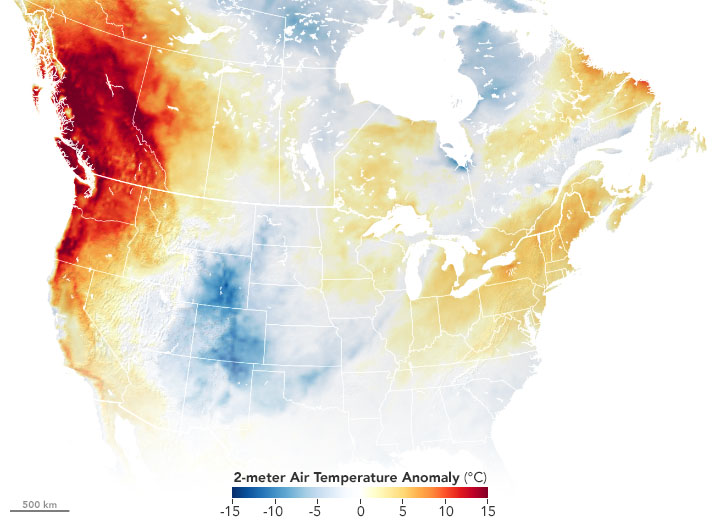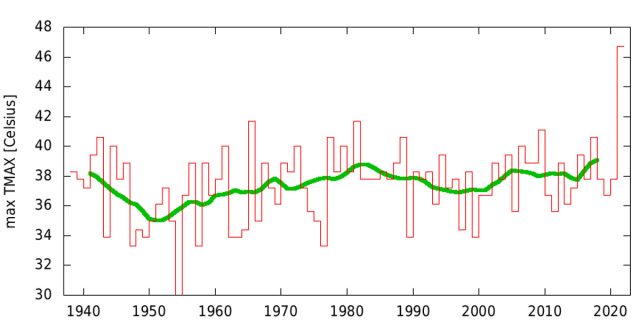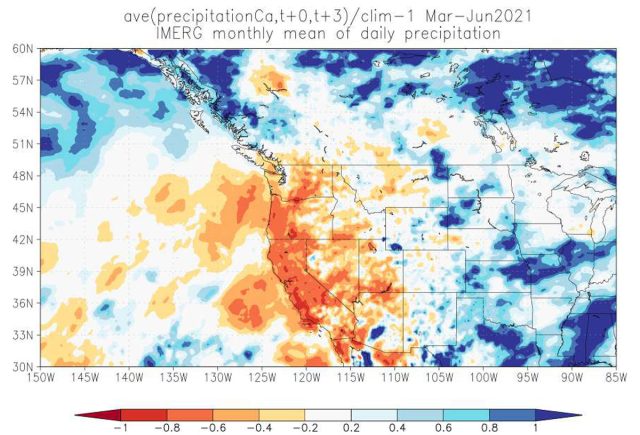Furnace blast —
Rapid analysis shows it would be hard to do this in a cooler world.
Scott K. Johnson
–

Enlarge / Temperatures compared to averages on June 27.
The last week of June saw shocking temperatures in Oregon, Washington state, and British Columbia. Differentiating a forecast in Canada from a forecast in Phoenix is usually a breeze, but not in June. All-time high-temperature records—not just daily records—were smashed across the region. Portland International Airport broke its all-time record of 41.7°C (107°F) by a whopping 5°C (9°F). The small town of Lytton set a new record high for the entire country of Canada at 49.6°C (121.3°F) on June 29. In the days that followed, most of the town burned in a wildfire.
Folks in this region are not accustomed to such extreme heat, with something like half of homes having air conditioners. The number of heat-related deaths is not yet fully known.

Enlarge / Maximum annual temperatures recorded at Portland International Airport.
Philip et al./WWA
As with other extreme weather events, the World Weather Attribution team has generated a rapid analysis of this heat wave in the context of climate change. The results were released Wednesday. The team coordinates scientists to perform a standard set of analyses—the method has been peer-reviewed, but this new paper obviously has not, yet.
That method includes a shotgun approach that starts with historical weather data. Focusing on a box between 45°N-52°N and 119°W-123°W that covers Portland, Seattle, Vancouver, and east to Washington’s Tri Cities, the researchers examined annual maximum temperatures over time. The goal is to fit a mathematical relationship that tells you how unusual an event was—it can produce figures like 1-in-10 or 1-in-50 odds in any given year, for example. But with events this extreme, the statistics are often challenging, as this heat wave went far beyond anything in the instrumental record. As near as they could estimate, the researchers put this heat wave at a 1-in-1,000 probability—the kind of thing that ought to happen roughly once in a thousand years.
Comparing this to the world before human-caused climate change requires adding in model simulations. As usual, the team compared historical temperatures in the area to a large database of models, tossing the simulations that fit the historical trend poorly. Statistics from simulations of climate in the late 1800s can then be combined with the historical data to see how rare this event would have been in the past.
The analysis estimates the probability of this heat wave in the cooler climate of the late 1800s would be at least 1-in-150,000 if not rarer. It’s an extreme event with climate change, but it’s an almost unthinkable event without climate change—”virtually impossible,” as the team puts it.
Another way to think about the heat wave is that a similarly extreme climate event in the late 1800s would have fallen around 2°C (3.6°F) short of the record that was just set.
The team also rolled that idea forward to the 2040s, when global warming is likely to clear the 2°C milestone. In that world, a 1-in-1,000 probability heat wave would be even hotter than this one was. The event that just occurred could improve to 1-in-10 odds—meaning we be would likely to see it again before too long.
The analysis contains an unusually direct description of what this implies for the region:
Our results provide a strong warning: our rapidly warming climate is bringing us into uncharted territory that has significant consequences for health, well-being, and livelihoods. Adaptation and mitigation are urgently needed to prepare societies for a very different future. Adaptation measures need to be much more ambitious and take account of the rising risk of heatwaves around the world, including surprises such as this unexpected extreme.
Deaths from extreme heat can be dramatically reduced with adequate preparedness action. Heat action plans that incorporate heat wave early warning systems can strengthen the resilience of cities and people. In addition, longer-term plans are needed to modify our built environments to be more adequate for the hotter climate that we already experience today and the additional warming that we expect in future. In addition, greenhouse gas mitigation goals should take into account the increasing risks associated with unprecedented climate conditions if warming would be allowed to continue.
The weather pattern that caused this had a couple of components. The jet stream set up in a stubborn “omega block” pattern, ridging northward to bring high pressure and air from the south. The strength of that high pressure hit a record for this area, although it wasn’t really that rare from a global perspective. (High pressure means air is descending towards the surface, heating up as it is compressed and maintaining a cloudless sky.)
Wind patterns exacerbated this, as warmer air moved in from areas further inland rather than mild air from over the Pacific. Wind that crosses the Cascade Mountains also compresses and heats up as it drops to the lower elevations near the coast. And because this region is in drought, there was little soil moisture to evaporate and cool the land, like sweat cools your skin. That allowed temperatures to climb higher than they would have otherwise.

Enlarge / Satellite-measured precipitation versus average for March-June. Clearly the spring didn’t help things any.
Philip et al./WWA
All the calculations in this analysis assume a sort of “bad luck plus climate change” explanation. An unlikely combination of weather events that can’t be blamed on climate change is made somewhat worse by the background temperature increase. But the researchers say there is another possibility—that climate change also affected the weather patterns themselves, with multiple influences compounding on each other. That could mean it’s already more likely than the 1-in-1,000 odds would imply.
There’s no clear evidence for this, and the team notes that models haven’t predicted it, either. But the degree to which this heat wave broke records seems to have left some researchers wondering if they’ve missed something. In a press release accompanying the analysis, Oxford University’s Friederike Otto said, “You’re not supposed to break records by four or five degrees Celsius (seven to nine degrees Fahrenheit). This is such an exceptional event that we can’t rule out the possibility that we’re experiencing heat extremes today that we only expected to come at higher levels of global warming.”
“It raises serious questions whether we really understand how climate change is making heat waves hotter and more deadly,” Geert Jan van Oldenborgh of the Royal Netherlands Meteorological Institute added.
The basic connection between global warming and extremely hot weather is obvious, and it is well established that heatwaves are worsening. Still, heatwaves like this one are capable of surprising us with their severity, serving as flashing red reminders of the consequences of a changing climate.
Listing image by NASA EO

